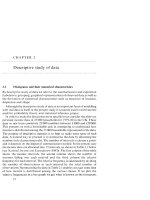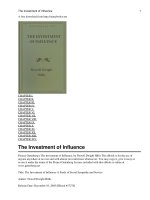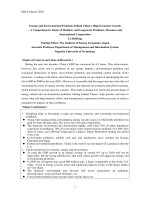Study of GDNF family receptor alpha 2 and inhibitory activity of GDNF family receptor alpha 2b (GFR alpha 2b) isoform
Bạn đang xem bản rút gọn của tài liệu. Xem và tải ngay bản đầy đủ của tài liệu tại đây (9.28 MB, 204 trang )
STUDY OF GDNF-FAMILY RECEPTOR ALPHA 2 AND
INHIBITORY ACTIVITY OF GDNF-FAMILY
RECEPTOR ALPHA 2B (GFRα2B) ISOFORM
YOONG LI FOONG
B.Sc.(Hons.), University of Putra Malaysia
A THESIS SUBMITTED
FOR THE DEGREE OF DOCTOR OF PHILOSOPHY
DEPARTMENT OF BIOCHEMISTRY
NATIONAL UNIVERSITY OF SINGAPORE
2007
II
Acknowledgements
Professor Too Heng-Phon always encourages students to forsake the secure
confinements, and plunge into ventures of discoveries and across foreign fields. Such
risky ventures are often greeted by discomfort and challenges; however, these can
also lead to discovery and insight. In pursuing the PhD training, I have been fortunate
to have Professor Too Heng-Phon as my mentor. Seamless discussions during many
afternoon after bench works and experiments, helped crystallize inchoate ideas and
concepts. Professor Too Heng-Phon has also modeled emancipating style that
contributed to progress immeasurably.
I would also like to thank Dr. Tang Bor Luen, unwittingly helped me with
seminal discussion at various stage. Friends and colleagues, principally including Dr.
Aji Kumar, Miss Peng Zhong Ni, Mr. Stephen Chen, Mr. Ng Jin Kiat, Mr. Tan Yew
Chung, forged an ever-helpful and vibrant team.
Lastly, I would like to express my deepest appreciation to my family, for their
support and understanding. Thanks and appreciations go to Linda Lau, for the
precious friendship.
III
Table of contents
Chapter 1 Introduction 1
1.1 Background ____________________________________________________________ 2
1.2 Motivations ____________________________________________________________ 2
1.3 Objectives _____________________________________________________________ 3
1.4 Organization of the thesis__________________________________________________ 3
Chapter 2 Literatures review 4
2.1 The neurotrophic factors __________________________________________________ 5
2.2 GDNF family of ligands (GFLs) ____________________________________________ 6
2.3 GDNF family receptors ___________________________________________________ 9
2.4 Alternatively spliced isoforms of GFRs and their co-receptors ____________________ 14
2.5 GFRα2 and GFRα1 receptor ______________________________________________ 15
Chapter 3 Part I: Glial cell-line derived neurotrophic factor and Neurturin
regulated the expressions of distinct miRNA precursors through the activation of
GFRα2. 17
3.1 Background and objectives _______________________________________________ 18
3.2 Results _______________________________________________________________ 21
3.2.1 Neuroblastoma BE(2)-C cells express GFRα2, NCAM and RET_________________ 21
3.2.2 Regulation of MAPK (ERK1/2) phosphorylation by GDNF and NTN ____________ 22
3.2.3 Regulation of miRNA precursor expressions by GDNF and NTN ________________ 24
3.2.4 Differentiation of BE(2)-C cells with GDNF and NTN ________________________ 27
3.3 Discussion ____________________________________________________________ 30
Chapter 4 Part II: Differential expressions, biochemical activities, and
neuritogenic activities of the alternatively spliced GFRα2 isoforms. 36
4.1 Background and objectives _______________________________________________ 37
4.2 Results _______________________________________________________________ 39
4.2.1 Differential expression profiles of GFRα2 spliced variants _____________________ 39
4.2.2 Establishment of Neuro2A cell models stably expressing GFRα2 isoforms. ________ 42
4.2.3 GFRα2 isoforms differentially activated ERK1/2 and Akt ______________________ 43
4.2.4 [
125
I]GDNF bound equally well to all three GFRα2 isoforms____________________ 47
4.2.5 GFRα2 isoforms activated different transcriptional genes ______________________ 48
4.2.6 Neurite outgrowths were induced by GFRα2a and GFRα2c, but not GFRα2b_______ 50
4.3 Discussion ____________________________________________________________ 53
Chapter 5 Part III: Ligand induced, RhoA dependent inhibitory activities of
GFRα2b isoform 55
5.1 Background and objectives _______________________________________________ 56
5.2 Results _______________________________________________________________ 59
5.2.1 GFRα2b inhibited neurite outgrowths mediated by other GFRα2 isoforms_________ 59
5.2.2 GFRα2b inhibited neurite outgrowth mediated by GFRα1a_____________________ 59
5.2.3 Knock-down of GFRα2b resulted in an increase in neurite outgrowths ____________ 62
5.2.4 Signaling and biochemical activities of GFRα2 isoforms in the co-expression model_ 63
5.2.5 GFRα2b inhibited retinoic acid induced neurite outgrowth _____________________ 67
5.2.6 Ligand induced GFRα2b neurite inhibition is RhoA dependent__________________ 68
5.2.7 GFRα2b may prevent but not retract neurite outgrowth________________________ 75
5.3 Discussion ____________________________________________________________ 78
Chapter 6 Part IV: Studies of inhibitory activities of GFRα1b isoform 81
6.1 Background and objectives _______________________________________________ 82
6.2. Results_______________________________________________________________ 83
6.2.1 Ligand activated GFRα1 isoforms mediated different early response genes ________ 83
IV
6.2.2 GFRα1a but not GFRα1b induced MAPK dependent-neurite outgrowth upon ligand
stimulations _________________________________________________________ 85
6.2.3 GFRα1b inhibited ligand induced neuritogenic activities of GFRα1a in a RhoA-ROCK
dependent mechanism _________________________________________________ 88
6.2.4 Differential regulation of GFRα1 and Ret isoforms expression in retinoic acid
differentiation of mouse embryonic stem cells_______________________________ 94
6.3 Discussion ____________________________________________________________ 97
Chapter 7 Part V: Neuritogenic mechanisms of GFRα2a and GFRα2c 100
7.1 Background and objectives ______________________________________________ 101
7.2 Results ______________________________________________________________ 103
7.2.1 Ligand activated GFRα2a and GFRα2c mediated neurite outgrowths via distinct
signaling pathways ___________________________________________________ 103
7.2.2 Withdrawals of ligands produced different effects on neurite outgrowth mediated by
GFRα2a and GFRα2c receptor isoforms __________________________________ 107
7.2.3 GFRα2a and GFRα2c share some similar neuronal markers upon ligand induced neurite
outgrowth __________________________________________________________ 110
7.3 Discussion ___________________________________________________________ 114
Chapter 8 Conclusion and future studies 118
8.1 Conclusion ___________________________________________________________ 119
8.2 Future studies_________________________________________________________ 119
8.2.1 Mechanism of ligand activated anti-neuritogenic activities of GFRα2b___________ 119
8.2.2 Hetero-oligomerization of isoforms ______________________________________ 120
8.2.3 Relative ratios of GFRα isoforms expression may affect functions ______________ 121
8.2.4 RET activations and RET isoforms_______________________________________ 121
8.2.5 Method development for simultaneous expressions detection of GFRα receptor isoforms
__________________________________________________________________ 122
8.2.6 In vivo studies of GFRα splice isoforms ___________________________________ 123
Chapter 9 Materials and methods 124
Chapter 10 References 139
Chapter 11 Appendices 155
Supplementary figures 155
List of publications 157
Abstracts communicated 158
Invited seminars and presentations 158
Reprints of publications 159
V
Abstract
The glial cell-line derived neurotrophic factor (GDNF) and neurturin (NTN)
belong to a structurally related family of neurotrophic factors. GDNF and NTN
exert their effects through a multi-component receptor system consisting of the
GDNF family receptor alpha (GFRα) and the co-receptor RET and/or NCAM.
GDNF preferentially binds to GFRα1, while GFRα2 is the cognate receptor for
NTN.
This study focused on the biochemical and morphological effects of ligand-
activated GFRα1 and GFRα2 isoforms. In the initial part of the study, GDNF
and NTN were found to activate distinct miRNA precursors in cells
endogenously expressing RET, NCAM and GFRα2 but not GFRα1, indicative of
specificity in ligand-receptor cross-talk.
There are at least three alternatively spliced isoforms of GFRα2 in the
nervous system: GFRα2a, GFRα2b, and GFRα2c. Quantitation using highly
specific and sensitive quantitative real-time PCR revealed comparable
expression levels of these isoforms in various regions of the human brain, lending
evidence to the idea that the isoforms may have physiological roles in the nervous
system. These isoforms showed ligand-selectivity in MAPK (ERK1/2) and Akt
signaling, and regulated different early response genes. When stimulated with
GDNF or NTN, both GFRα2a and GFRα2c, but not GFRα2b, promoted neurite
outgrowth in transfected Neuro2A cells. In co-expression studies, GFRα2b was
found to inhibit ligand-induced neurite outgrowths mediated by GFRα2a,
GFRα2c, and GFRα1a, another member of the GDNF family receptor.
Furthermore, activation of GFRα2b also inhibited neurite outgrowths induced
by retinoic acid and the inhibitory activities were RhoA dependent. On the other
VI
hand, the ligand-induced neurite outgrowths through GFRα2a and GFRα2c
isoforms showed distinct signaling mechanisms.
Differential biochemical and neuritogenic activities also exist with the GFRα1
receptor isoforms, GFRα1a and GFRα1b. When co-expressed, GFRα1b
antagonized neurite outgrowth mediated by GFRα1a, in a RhoA-ROCK
dependent manner.
The results from this study suggest a novel paradigm for the regulation of
growth factor signaling and neurite outgrowth via an inhibitory splice variant of
the receptor. Thus, depending on the expressions of specific GFRα2 and GFRα1
receptor spliced isoforms, GDNF and NTN may promote or inhibit neurite
outgrowth through the same multi-component receptor complex. The emerging
view is that the combinatorial interactions of the spliced isoforms of GFRα1,
GFRα2, RET and NCAM may contribute to the complexity of multi-component
signaling system and produce a myriad of observed biological responses.
VII
List of figures
Figure 1.1. Amino acids sequence alignment of mature GDNF family ligands
(GFL).
Figure 1.2. Amino acid sequence comparison of GFRα1, GFRα2, GFRα3, and
GFRα4.
Figure 1.3. Schematic diagram of GFLs binding to GFRα receptors.
Figure 1.4. Phylogenetic analysis of GDNF Family Ligands (GFL) and GFR
superfamily proteins, adapted from (Airaksinen et al., 2006).
Figure 3.1. Expression levels of GFRα, RET and NCAM transcripts in human
neuroblastoma BE(2)-C cells by quantitative real time PCR.
Figure 3.2. GDNF and NTN induced MAPK (ERK1/2) phosphorylation in BE(2)-
C cells.
Figure 3.3. Real time PCR amplification of miRNA precursors.
Figure 3.4. Regulation of miRNA precursor expressions by GDNF and NTN.
Figure 3.5. Inhibition of miRNA precursor expressions by U1026 in ligand
stimulated cells.
Figure 3.6. Retinoic acid differentiation of BE(2)-C cells.
Figure 3.7. Proposed model for multiple pathways required for selection and
activation of specific transcriptional factors in regulation of microRNA
(miRNA) precursors expression.
Figure 4.1. Real time PCR quantification of GFRα2 isoforms expression in
different human brain regions.
Figure 4.2. Quantitative real time PCR assay for human GFRα2 isoforms.
Figure 4.3. Real time PCR quantification of GFRα2 isoforms expression in
different human brain regions.
Figure 4.4. Establishment of Neuro2A cell models stably expressing GFRα2
isoforms.
Figure 4.5.
Ligand stimulated ERK1/2 activation in GFRα2 isoforms transfected
Neuro2A cells.
Figure 4.6. Kinetic analysis and dose response of GDNF and NTN regulation of
ERK1/2 activation in GFRα2 isoforms transfected Neuro2A cells.
VIII
Figure 4.7.
Ligand stimulated Akt activation in GFRα2 isoforms transfected
Neuro2A cells.
Figure 4.8. Displacement of [
125
I ]GDNF by unlabeled GDNF in GFRα2 isoforms
transfected Neuro2A cells.
Figure 4.9. Kinetic analyses of the regulations of early response genes by GDNF
and NTN in GFRα2 isoforms transfectants.
Figure 4.10. Differential neuritogenic activities of ligand activated GFRα2 isoforms.
Figure 4.11. Immunocytochemistry of cytoskeletal component in ligand treated
Neuro2A cells expressing GFRα2 isoforms.
Figure 5.1. GFRα2b antagonized neurite outgrowths of GFRα2a and GFRα2c in
co-expression models.
Figure 5.2. Ligand activated GFRα2b antagonized neurite outgrowth induced by
ligand activated GFRα1a in co-expression model.
Figure 5.3. Silencing of GFRα2b expression in human BE(2)-C cells.
Figure 5.4. ERK1/2 signaling and the regulation of early response genes in the co-
expression of GFRα2b with either GFRα2a or GFRα2c.
Figure 5.5. Ligand activated GFRα2b antagonized neurite outgrowth induced by
retinoic acid.
Figure 5.6. Effects of RhoA and ROCK inhibitors in ligand-induced neurite
outgrowth of GFRα2 isoforms co-expression models.
Figure 5.7. Analyses of RhoA activation in Neuro2A cells transfected with GFRα2
isoforms or pIRES control.
Figure 5.8. Effects of RhoA and ROCK inhibitors on GFRα2b inhibition of
retinoic acid (RA) induced neurite outgrowth.
Figure 5.9. RhoA dominated negative mutant prevented inhibitory effects of
GFRα2b.
Figure 5.10. Ligand activated GFRα2b mediated phosphorylation of cofilin.
Figure 5.11. Ligand activated GFRα2b may prevent, but not retract neurite
outgrowth mediated by Retinoid Acid.
Figure 6.1. GDNF and NTN regulated different early response genes in GFRα1a
and GFRα1b expressing cells.
Figure 6.2. GFRα1 isoforms mediated distinct neuritogenic activities.
IX
Figure 6.3. Confocal images for double staining of heavy chain neurofilament
(NH-F) and F-Actin in GFRα1a or GFRα1b treated with GDNF.
Figure 6.4. GFRα1b attenuated ligand induced neurite outgrowth in GFRα1a when
co-expressed.
Figure 6.5. GFRα1b attenuated ligand induced neurite outgrowth of GFRα1a, in a
Rho-ROCK dependent mechanism.
Figure 6.6. RhoA dominate negative mutant prevented inhibitory effects of
GFRα1b.
Figure 6.7. Combinatory effect of retinoic acid and GDNF ligands on neuritogenic
activities of GFRα1 isoforms.
Figure 6.8. Differential regulation of GFRα1 and Ret isoforms gene expressions in
retinoic acid induced neuronal differentiation of mouse embryonic
stem cells.
Figure 7.1. Effects of kinase inhibitors on ligand induced neurite outgrowth in
GFRα2a or GFRα2c transfected Neuro2A cells.
Figure 7.2. Effects of kinase inhibitors on ERK1/2 activation in GFRα2a and
GFRα2c cells.
Figure 7.3. Study of retinoic acid withdrawal effects on differentiation of Neuro2A
cells.
Figure 7.4. Study of ligand withdrawal effects on neurite outgrowth mediated by
GFRα2 isoforms in Neuro2A transfectants.
Figure 7.5. Regulation of CRMP3 gene expression by GFRα2a and GFRα2c, in
Neuro2a cells stably expressing these receptor isoforms.
Figure 7.6. Regulation of GABAergic markers by GFRα2a and GFRα2b, in
Neuro2a cells stably expressing these receptor isoforms.
Figure 7.7. Schematic diagram of signaling mechanisms involved in ligand
induced neurite outgrowth of GFRα2a and GFRα2c receptor isoforms.
X
List of tables
Table 1.1 Chromosome locations of Mus muculus and Homo sapiens GFRα
receptors genes.
Table 9.1 List of primers used for amplification of mouse GFRα2, GFRα1
isoforms, Ret, NCAM and GAPDH.
Table 9.2 Design of siRNA for human GFRα2b.
Table 9.3 List of primers used for amplification and measurement of human pri-
miRNA.
Table 9.4 List of primers used for amplification of human GFRα2, GFRα1, Ret,
NCAM and GAPDH.
Table 9.5 List of primers used for amplification of human GFRα2 isoforms and
GAPDH.
Table 9.6 List of primers used for amplification of mouse early response genes.
Table 9.7 List of primers used for measurement of mouse neuronal markers.
XI
Abbreviations
ART Artemin
CRMP Collapsin response mediator proteins
ERK1/2 extra-cellular signal regulated kinase 1/2
FBS fetal bovine serum
GAD glutamate decarboxylase
GDNF glial cell line-derived neurotrphic factor
GFL GDNF family ligands
GFRα GDNF family of receptors alpha
GPI glycosyl-phosphotidylinositol
LPA lysophosphatidic acid
MAPK mitogen-activated protein kinase
MCS multiple-cloning site
mESC mouse embryonic stem cells
miRNA microRNA
NCAM neural cells adhesion molecules
NTN Neurturin
PBS phosphate buffered saline
PCR polymerase chain reaction
pre-miRNA precursor miRNA
pri-miRNA primary miRNA
PSP Persephin
RA retinoic acid
RET rearranged during transformation
RhoA Ras homologous member A
ROCK Rho-associated kinase
RTKs receptor tyrosine kinases
TGF-β transforming growth factor beta (TGF-β)
Chapter 1 Introduction
1
Chapter 1 Introduction
Chapter 1 Introduction
2
1.1 Background
The glial cell-lined derived neurotrophic factor (GDNF) and neurturin (NTN) belong
to a structurally related family of neurotrophic factors. GDNF and NTN exert their
effects through a multi-component receptor system. GDNF and NTN bind to specific
GDNF family receptors (GFRα), which are linked to the plasma membrane by a
glycosyl-phosphotidylinositol (GPI) anchor. These receptors then transduce
intracellular signals by activating the co-receptor, RET (a transmembrane tryrosine
kinase), and/or NCAM. GFRα1 and GFRα2 are the preferred receptors for GDNF and
NTN, respectively. Both ligands have potent trophic effects in many neuronal systems,
including the midbrain dopaminergic neurons, making it a strong therapeutic
candidate for several neurodegenerative diseases. Clinical trials I/II using GDNF and
NTN transgene are currently being explored as therapeutics for Parkinson’s disease.
1.2 Motivations
Despite the many efforts to unravel the biological functions of GDNF, the
mechanisms underlying receptor-ligand interactions and signalings remain unclear.
Our laboratory and several others have previously identified alternatively spliced
isoforms of GFRα1 and GFRα2. The biological significance of these alternative
spliced variants remains uncertain. Hence, it is the intention of this work to gain a
better understanding of the biochemical properties, cellular functions and biological
activities of the alternatively spliced GFRα2 receptor isoforms.
Chapter 1 Introduction
3
1.3 Objectives
This piece of work focused primarily on the study of the interactions of GDNF and
NTN with the alternatively spliced GFRα2 isoforms. GFRα2 receptor is spliced to
produce three isoforms, namely GFRα2a (contains all 9 exons), GFRα2b (lacking
exon 2), and GFRα2c (lacking exon 2 and 3). In order to gain a better understanding
of the biological significance, the expression levels of GFRα2 isoforms in different
regions of the human brain were determined and their biochemical activities and
phenotypical functions in inducing morphological changes, were characterized in
vitro. The study was then extended to another structurally related family of receptors,
the GFRα1 isoforms.
1.4 Organization of the thesis
This thesis is organized into five sections according to the results and findings. The
first study focused on ligand-receptor specificity using a human neuroblastoma cell
line that endogenously expresses the GFRα2 and the co-receptors, RET and NCAM
(Chapter 3). The second section deals with the biochemical and neuritogenic activities
of GFRα2 receptor isoforms using transfected Neuro2A cell models (Chapter 4). The
third section deals with the mechanism underlying the neurite outgrowth inhibitory
activities of the GFRα2b in more detail (Chapter 5). This is then followed by the
studies of GFRα1 isoforms and demonstrations of some similarities between GFRα1b
and GFRα2b on regulating neurite outgrowths inhibitions (Chapter 6). The final
section (Chapter 7) focuses on the signaling differences underlying neurite outgrowth
mechanisms of GFRα2a and GFRα2c isoforms. The thesis concludes with some
suggestions for future works (Chapter 8).
Chapter 2 Literatures review
4
Chapter 2 Literatures review
Chapter 2 Literatures review
5
2.1 The neurotrophic factors
Neurotrophic factors are polypeptides that are crucial for the growth,
differentiation and survival of neurons in the developing nervous system, and also
play roles in functional maintenance of neurons in the mature nervous system (Blesch,
2006). Nerve growth factor (NGF) was the first neurotrophic factor discovered which
was first shown to be target derived. The discovery and understanding of NGF led to
the formulation of the Neurotrophic Factor Hypothesis, which postulates that:
“…once a developing neuron has grown its process into its target, it competes with
other developing neurons of the same type for a limited supply of a neurotrophic
factor provided by the target” (Yuen et al., 1996). In this hypothesis, the successful
competitors for neurotrophic factor survive, while the unsuccessful ones die.
The fact that some but not all isolated neurons responded to NGF, led to the
speculation that there are likely to be more neurotrophic factors and their effects
should be neuron specific. Thereafter, other members of the NGF family
(neurotrophins) were discovered, which include brain derived neurotrophic factor
(BDNF), neurotrophin-3 (NT-3), neurotrophin-4/5 (NT-4/5).
In the early 1990s, in the pursuit to discover dopaminergic neuron specific
supporting factors, glial cell line-derived neurotorphic factor (GDNF) was purified
from culture supernatants of the glial cell line B49 and the gene cloned (Lin et al.,
1993). Other GDNF family members, Neurturin (Kotzbauer et al., 1996), Artemin
(Baloh et al., 1998) and Persephin (Milbrandt et al., 1998) were subsequently
identified and the genes cloned. More than one decade after the discovery of GDNF,
the continuing efforts and interests are now focusing on understanding the functions
and signaling mechanisms of this family of ligands (GDNF family of ligands, GFLs)
Chapter 2 Literatures review
6
and receptors (GDNF family of receptors alpha, GFRα) in neuronal and non-neuronal
systems.
2.2 GDNF family of ligands (GFLs)
Glial cell-line derived neurotrophic factor (GDNF), Neurturin (NTN), Artemin
(ARTN) and Persephin (PSPN) are cysteine-knot proteins and are structurally related
neurotrophic factors (Airaksinen and Saarma, 2002; Kobori et al., 2004). These GFLs
have been shown to support the growth, maintenance and differentiation of a wide
variety of neuronal and extra-neuronal systems (Saarma and Sariola, 1999).
Structurally, GFLs belong to the transforming growth factor beta (TGF-β)
superfamily, sharing the seven conserved Cys residues (depicted in Figure 1.1). GFLs
are biosynthesized as precursors and further processed into the mature forms of
disulfide-bonded dimeric, basic and secretory proteins.
GDNF and the other GFLs act as trophic factors for many central and peripheral
neuronal systems, such as the sensory, enteric, sympathetic, and parasympathetic
(Airaksinen and Saarma, 2002; Airaksinen et al., 1999). GDNF also has functions in
some non-neuronal systems, such as in kidney development and spermatogonial
differentiation (Sariola, 2001; Sariola and Saarma, 1999). Because GDNF has potent
neurotrophic effects on midbrain dopaminergic neurons and other neuronal systems, it
is perhaps not surprising that GDNF is considered a useful therapeutic for some
neurodegenerative diseases. Indeed, GDNF has been used in clinical trials and the
results are favorable in some reports (Gill et al., 2003; Slevin et al., 2005) but not in
others (Nutt et al., 2003; Peggy, 2005). It is now believed that the failure of some of
these clinical trials may simply be technical variability resulting in the suboptimal
bioavailability of GDNF (Salvatore et al., 2006) and statistical errors (Hutchinson et
al., 2006). The difficulty of delivering large proteineous factors may one day be
Chapter 2 Literatures review
7
circumvented by the use of small molecular mimetics which show biochemical
properties similar to GDNF and the other GFLs (Bespalov and Saarma, 2007).
Although NTN and GDNF are structurally related, the tissue distributions of their
cognate receptors do not share significant overlaps, indicative of possible distinct
functional roles (Golden et al., 1999; Widenfalk et al., 2000). When compared to
GDNF, the chronic administration of NTN produces specific neurochemical changes
only in the ventrolateral striatum with no detectable adverse effects, raising the
possibility that NTN may also serve as a useful therapeutic (Hoane et al., 1999). A
Phase I clinical trial using an in vivo Adeno-associated Virus Type 2 (AAV2)
mediated delivery of the gene encoding NTN (CERE-120) is currently underway
(
).
With the better understanding of structure-functions of the molecules,
physiological roles and signaling mechanisms of GFLs, it may enable the rational
development of efficacious therapeutics for diseases related to this family of ligands
and receptors.
Chapter 2 Literatures review
8
Figure. 1.1 Amino acids sequence alignment of mature GDNF family ligands
(GFL). A, Amino acids sequence alignment of rat GDNF, human Artemin (hART),
human Neurturin (hNTN), and human Persephin (hPSP). Boxed regions show
position of the conserved cysteine residues. Secondary structure elements are
indicated above the alignment (“α” for α-helix; “β” for β strand). Regions in color
correspond to color scheme shown in B. B, Representation of backbone of the GDNF
dimer. The first (blue) and second (red) fingers, and the heel (green) region of the
molecule are shown. Figure B, adapted from Baloh et al, 2000.
Chapter 2 Literatures review
9
2.3 GDNF family receptors
GFLs exert their effects through a multi-component receptor system consisting of
the GDNF family receptor alpha (GFRα), RET (re
arranged during transformation)
and/or NCAM (neural cells adhesion molecules) (Airaksinen et al., 1999; Paratcha et
al., 2003). The GFRα family consists of four members (GFRα1 to 4) that are linked
to the plasma membrane via glycosyl-phosphotidylinositol (GPI) anchor. The
homologs of the genes encoding these receptors are found in different chromosomes
(Table 1.1). GFRα receptor family members share 30-45% amino acid identity, with
similar conserved cysteine residue arrangements (Figure 1.2), suggesting that their
secondary structures may also be conserved (Scott and Ibanez, 2001). A comparison
of these GFRα receptors amino acids reveals internal structural homologies within the
conserved cysteine rich sequences, suggesting common putative domain structures for
these receptors.
Table 1.1 Chromosome locations of Mus muculus and Homo sapiens GFRα
receptors genes. The genetic loci are described in the NCBI Mapviewer, build 36 for
both organisms.
Gene of receptor Chromosome Location
Mouse GFRα1 19 D2-D3; 29.0 cM
GFRα2 14 D3-E1
GFRα3 18 B1
GFRα4 2 F1 73.9 cM
Human GFRα1 10q26
GFRα2 8p21.3
GFRα3 5q31.1-q31.3
GFRα4 20p13-p12
Chapter 2 Literatures review
10
Figure 1.2 Amino acid sequence comparison of GFRα1, GFRα2, GFRα3, and
GFRα4. The amino acid sequence of rat GFRα1, GFRα2, human GFRα3, and
chicken GFRα4 are aligned and the conserved cysteines are boxed in red. Sequences
predicted to correspond to α helix (blue) and β strand (purple) are highlighted.
Predicted N-terminal signal peptide sequences and the C-terminal hydrophobic
regions are underlined. Figure modified from Scott and Ibanez, 2001.
Chapter 2 Literatures review
11
Each GFL is known to bind itself to a preferential GFRα receptor (depicted in
Figure 1.3). GFRα1 is found to be the cognate receptor for GDNF (Jing et al., 1996;
Treanor et al., 1996). NTN signals through its preferred receptor GFRα2 (Baloh et al.,
1997; Buj-Bello et al., 1997; Klein et al., 1997; Widenfalk et al., 1997). Artemin and
Persephin signals through GFRα3 and GFRα4, respectively.
Upon ligand binding to these GFRα receptors, intracellular signals are transduced
through the trans-membrane receptor tyrosine kinase, RET. Recent findings suggest
that NCAM may also function as the co-receptor for GFLs-GFRα signaling (Paratcha
et al., 2003), adding to the complexity of the signaling mechanism of GFLs and
GFRα.
The key role of GDNF and its receptor GFRαl in enteric nervous system
development is conserved from zebrafish to humans. The role of Neurturin, signals
via GFRα2, for parasympathetic neuron development is also conserved between
chicken and mice. The role of Artemin and Persephin that signals via GFRα3 and
GFRα4, respectively, is currently unknown in non-mammals. Recent phylogenetic
study (Airaksinen et al., 2006; Hatinen et al., 2006) indicates that orthologs of all
four GFL are present in mammals, as well as in bony fish (teleost) (Figure 1.4A).
Orthologs of all GFRα receptors are also present in all vertebrates classes, from bony
fish to mammals (Figure 1.4B). However, Persephin is missing from chicken genome,
while frog genome lacks ortholog of Neurturin (Hatinen et al., 2006), suggesting
functional redundancy in early tetrapods. The functional significance of non-
mammalian GFLs and GFRα signaling remains unclear.
Recently, distantly related GFRα-like structures have been identified. Based on
the conserved pattern of cysteines (and the presence of some amino acid residues),
these sequences include Gas1, growth arrest specific 1 protein, (Cabrera et al., 2006;
Chapter 2 Literatures review
12
Schueler-Furman et al., 2006) and GRAL (GDNF Receptor Alpha Like), a protein
found in some regions of the central nervous system of unknown function (Li et al.,
2005). In addition, genomic sequences encoding a predicted protein in echinoderm
sea urchin (Strongylocentrotus purpuratus) that shows clear homology to vertebrate
GFRα and GRAL proteins but no known function has been identified and this
hypothetical protein is called GDNF family receptor-like (GFRL) (Hatinen et al.,
2006). Unlike the GFRα1-4, GRAL and Gas 1 function independently of GFLs.
Hence, these related proteins may have distinct ligands which are not GFLs.
Figure 1.3. Schematic diagram of GFLs binding to GFRα receptors. GDNF, NTN
(Neurturin), ART (Artemin), and PSP (Persephin) bind to preferred GFRα receptors
(indicated by solid, black arrows), and activate (indicated by dashed, red arrows)
transmembrane Ret tyrosine kinase receptor to transduce intracellular signaling
(indicated by solid, red arrows). Promiscuous binding between GFL and non-
preferred receptors are also shown (dotted, black arrows).
Chapter 2 Literatures review
13
Figure 1.4. Phylogenetic analysis of GDNF Family Ligands (GFL) and GFR
superfamily proteins. A, The tree was generated by comparing the mature part of the
GFLs (NRTN for Neurturin, PSPN for Persephin, and ARTN for Artemin) using the
maximum likelihood method. Threadworm (Strongyloides stercoralis) TGFP-like
protein was used as the outgroup. Note the absence of PSPN in chicken and NRTN in
clawed frog. B, Phylogenetic tree of GFR superfamily proteins in selected animal
species. The tree was generated by comparing the conserved part of the proteins. The
branches lengths are proportional to the expected proportion of amino acid differences
among groups. Figures adapted from Airaksinen et al, 2006.
Chapter 2 Literatures review
14
2.4 Alternatively spliced isoforms of GFRs and their co-receptors
Alternative splicing is prevalent in many mammalian genomes and is a means of
producing functionally diverse polypeptides from a single gene (Blencowe, 2006).
Recently, genome-wide microarray and large-scale computational analyses of
expressed sequence tag and cDNA sequences have estimated that greater than 50% of
human multi-exon genes are alternatively spliced (Modrek and Lee, 2002).
Comparative genomic analyses further demonstrate that the greatest amount of
conserved alternative splicing occurs in the central nervous system (Kan et al., 2005).
In many systems, alternative splicing events have been shown to produce isoforms
with distinct activities and biochemical properties as a means for diverse biological
functions (Lee and Irizarry, 2003).
Multiple alternatively spliced variants of GFRα1 (Dey et al., 1998; Sanicola et al.,
1997; Shefelbine et al., 1998), GFRα2 (Dolatshad et al., 2002; Wong and Too, 1998)
and GFRα4 (Lindahl et al., 2001; Lindahl et al., 2000; Masure et al., 2000) have been
reported. The alternatively spliced isoforms of GFRα1 have been shown to exhibit
distinct biochemical functions (Charlet-Berguerand et al., 2004; Yoong et al., 2005).
Similarly, alternatively spliced isoforms of the GFRα co-receptors, RET (de Graaff et
al., 2001; Lee et al., 2002a; Lorenzo et al., 1997) and NCAM (Buttner et al., 2004;
Povlsen et al., 2003) have been reported. Ret9 and Ret51 are the two spliced isoforms
of RET, both of which have been shown to possess distinct biochemical and
physiological functions (de Graaff et al., 2001; Lee et al., 2002a; Lorenzo et al.,
1997). These observations are consistent with the emerging view that the
combinatorial interactions of the spliced isoforms of GFRα, RET and NCAM may
contribute to the multi-component signaling system in producing the myriad of
observed biological responses. The existence of multiple splice isoforms of GFRα,









